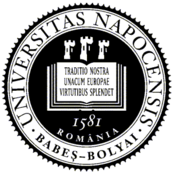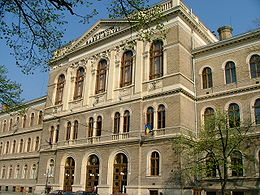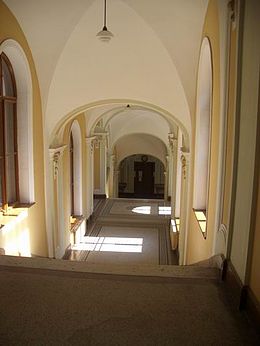- Babeș-Bolyai University
-
"Babeș-Bolyai" University Universitatea "Babeș-Bolyai" 
Seal of the Babeș-Bolyai UniversityLatin: Universitas Napocensis Motto Traditio Nostra Unacum Europae Virtutibus Splendet Established 1581/1959 Type Public Endowment $121,947,739[1] Rector Prof. univ. dr. Andrei Marga President of The Academical Consilium Şerban Agachi Academic staff 1,700 Students 49,619[2] Location Cluj-Napoca, Romania Former names Universitatea din Cluj
Universitatea din Cluj la SibiuNickname Babeș Website www.ubbcluj.ro
The main building The Babeș-Bolyai University (UBB—Universitatea Babeș-Bolyai, Hungarian: Babeș-Bolyai Tudományegyetem) in Cluj-Napoca is an university in Romania. With almost 50,000 students, the university offers 105 specialisations, of which there are 105 in Romanian, 67 in Hungarian, 17 in German, and 5 in English. The university was named after prominent scientists from Transylvania, Romanian bacteriology scientist Victor Babeș and the Hungarian mathematician János Bolyai.
The Babes-Bolyai University was ranked, as concerning research, as the first in Romania (2002-2011), based on article influence score (Web of Science), by Ad-Astra Association of Romanian Scientists [1], followed by Bucharest University (placed second). Also, in 2011, in the URAP international ranking, Babes-Bolyai University was ranked first in Romania based on top academic indicators; it is followed by Bucharest University [2]. In the top Quacquarelli Symonds (known from The Times Higher Education Supplement), the University Babeș-Bolyai was placed in 2011 on the position 601+, being thus among best 1000 universities of the world.[3] University of Bucharest is place in 2011 on the same rank. In a recent ranking regarding the impact of universities on professional market (i.e., credibility and attractiveness), Babes-Bolyai University was ranked number 1 University in Romania in 2009 by the German company Kienbaum Management Consultants and Capital magazine.[4] BBU is followed by University of Bucharest which is the second.
Contents
History
In 1581, István Báthory, prince of Transylvania, founded a college in Kolozsvár (now: Cluj) which was to be under the control of the Jesuits. This college was later closed down. The Catholics in 1688 established an academy in Kolozsvár under the control of the Jesuits. In 1776, Empress Maria Theresa founded a university in the town.
In 1872, the Hungarian Minister of Education, József Eötvös presented to the Hungarian Parliament a project of a new university to be founded either in Pozsony (present Bratislava) or Kolozsvár. After long debates on financial concern the Hungarian Parliament voted for the latter. Thus, the authorities established a university in Kolozsvár with teaching in Hungarian, except for the Romanian language and literature section. In 1881 the university was renamed Franz Joseph University after the Habsburg Emperor and King of Hungary Franz Joseph.
On May 12, 1919, after the Union of Transylvania with Romania, the Romanian University of Cluj was set up. King Ferdinand proclaimed the university open on February 1, 1920, while its Hungarian section moved to Szeged.
In 1940, as a result of the Second Vienna Award, the city was returned to Hungary; the Hungarian university was reinstated there, while the Romanian university was moved to Sibiu and Timişoara. After World War II, once the Second Vienna Award was abrogated, the Romanian university returned to Cluj and took the name of Babeș. In 1945 the Romanian authorities established a Hungarian university called "Bolyai" in Cluj.[5]
In 1959 communist authorities decided to merge the two universities, the "Babeș" University and the "Bolyai" University under the "Babeș-Bolyai" University name, with Romanian and Hungarian teaching languages. This operation, which deeply undermined the interests of the Hungarian community in Transylvania and led to the suicide of a Hungarian pro-rector[6] and a professor,[7] was orchestrated[citation needed] by Nicolae Ceauşescu, the former Romanian dictator, and Ion Iliescu, his successor as president. Later on, under the communist regime, the studies in Hungarian were gradually reduced.
After the Romanian Revolution of 1989 in which ethnic Hungarians had a major role, the Hungarian language education was expanded by increasing the number of specializations in Hungarian. Also specializations taught in German and English have been introduced.
The university is now the most diversified (in terms of specializations) and the most complex higher education institution in Romania.[citation needed]
Academics
The university has 21 faculties and over 1,700 faculty members. The University offers bachelor's, master's, and Ph.D. degrees, along with advanced postgraduate studies.
The university is located in an ethnically diverse area and this is very well illustrated in its structure: 19 of the 21 faculties provide a Romanian curriculum; 17 of them provide a Hungarian curriculum; 9 of them provide a German curriculum and 6 of them provide an English curriculum. The Faculty of Roman Catholic Theology and the Faculty of Protestant Theology provide courses only in Hungarian. Graduate schools offer the same multilingual structure. The Hungarian and German minorities are also very well represented in the Professors' Council and the University Senate.
Babeș-Bolyai University has more than 45,000 students. The structure of the student body is composed out of 3,000 Ph.D. students, 500 international students, 4,300 secondary education teachers, and 38,000 undergraduate. Here is the list of the faculties, along with the languages in which their courses are taught—(RO-Romanian, HU-Hungarian, DE-German,FR-French, EN-English).
- Faculty of Mathematics and Computer Science RO HU DE EN
- Faculty of Physics RO HU DE
- Faculty of Chemistry and Chemical Engineering RO HU DE EN
- Faculty of Biology and Geology RO HU DE
- Faculty of Geography RO HU DE
- Faculty of Environmental Science RO HU
- Faculty of History and Philosophy RO HU DE
- Faculty of Psychology and Science of Education RO HU
- Faculty of Political Science and Public Administration RO HU DE EN
- Faculty of Letters RO HU DE
- Faculty of Theatre and Television RO HU
- Faculty of Law RO HU
- Faculty of Economics RO HU DE EN FR
- Faculty of Physical Education and Sport RO HU
- Faculty of European Studies RO DE EN
- Faculty of Sociology and Social Work RO HU
- Faculty of Business RO EN
- Faculty of Orthodox Theology RO
- Faculty of Greek Catholic Theology RO
- Faculty of Roman Catholic Theology HU
- Faculty of Protestant Theology HU
The status of Hungarian "part" of the university
The Hungarian academic community at the University has a partial autonomy that was gradually increased in the last several years[citation needed]. However, in the opinion of the Council of the Hungarian section, those members are appointed by the Hungarian speaking teaching staff desires a granted, a more institutionalized form of decision making, taking into consideration the a long university tradition of the Hungarian community and generalized demands of Hungarians in Romania for cultural and educational autonomy. Decision-making is based on majority vote, therefore Hungarian representatives in minority can always be silenced by this procedure. Hungarian Language is used in academical communication, as a teaching language, but also used in public relations, tutorials, in some written posters and communications, but the legends, inscriptions, classroom labels are only in Romanian, so the image and the feeling is not of a real multilingual university. In Hungarian section are enrolled near 7200 students in 67 BA programmes, so the university is the most important institution that educate members of Hungarian minority in Transylvania. Establishment of Hungarian faculties was impeded several times, albeit asked by more than 80% of the Hungarian professors. Last time, on 22 February 2006, the University Senate neglected the demand of 149 Hungarian professors. Moreover, there are no Hungarian inscriptions, the Hungarian language cannot be used as a language of formal communication within the University.
In November 2006, dr. Péter HANTZ and dr. Lehel KOVÁCS, both lecturers at the Babeș-Bolyai University, were sacked by the university after a series of actions taken for, what they call, the language equality, started in October 2005. They were campaigning for the re-establishment of the Bolyai University by splitting the Babes-Bolyai University in two independent institutions, in spite of the threats of the Universitry management.[citation needed]
On 22 November 2006, the University organized an exhibition in the European Parliament, where they tried to give the impression that there are multilingual signs at the University. In the same day, dr. Péter Hantz put up signs like "Information" and "No smoking" in Hungarian alongside those ones in Romanian.[8] Hantz and Kovács acted upon a decree permitting the use of multilingual signs, which had been decreed by the university but never put in practice, and official claims that the university is a multicultural institution with three working languages (Romanian, German and Hungarian).[9] On 27 November 2006, the Senate voted for exclusion of the two lecturers, with 72 for and 9 against (from 2 Romanian and 7 Hungarian members) votes. The Hungarian academic community is convinced that the exclusion was not a disciplinary action, but the vote was not ethnic based.In spite of various protests, the resignation out of solidarity by several Hungarian-speaking university staff, and a call by 24 Hungarian MEPs for the reinstatement of the lecturers in the weeks after the incident, the lecturers remained unemployed.[8] The parties in the Hungarian Parliament asked the university to reinstate the two professors and respect the rights of the Hungarian minority. The presidents of the five parties represented in the Hungarian parliament signed a statement that read as follows:[9]
"The expulsion of the two young educators tells Hungary's parliamentary representatives that there are still people in Romania who believe that in the 21st century the desires for democratic higher education of a 1.5-million-strong community can be denied."Istvan Hiller, Education Minister of Hungary, also wrote to his Romanian counterpart Mihail Hărdău, asking for his help on the issue.[9] The case has also been put forward in the Parliamentary Assembly of the Council of Europe. Göran Lindblad, from the Swedish European People’s Party, along with 24 signatories from 19 European countries, presented a motion for a resolution on the alleged breaching of the 1994 Framework Convention for the Protection of National Minorities by the Romanian Government.[10]
Campus
The main campus is located in the city of Cluj-Napoca. The university buildings are spread across the city. The university has several student housing areas, most notable being Haşdeu with more than 20 dormitories buildings. The Lucian Blaga University Library is located in the city centre. The university also has several colleges located in 18 cities spread across Transylvania.
See also
- Balkan Universities Network
- Iuliu Haţieganu University of Medicine and Pharmacy
- List of modern universities in Europe (1801–1945)
References
- ^ Bugetul de venituri şi cheltuieli pe anul 2007
- ^ Universitatea Babes-Bolyai astazi
- ^ 2009 World University Rankings 500 plus QS Quacquarelli Symonds Limited.
- ^ EXCLUSIV: Topul universităţilor din România
- ^ A significant history
- ^ Dennis Deletant (1995). Ceauşescu and the Securitate. p. 112. ISBN 9781563246333. http://books.google.hu/books?id=XmmilITRkxYC&pg=PA112&lpg=PA112.
- ^ "Bolyai University - History". http://www.bolyai.eu/tortenet_en.php.
- ^ a b Eurolang.net Sacked Hungarian lecturers fail to get re-instated
- ^ a b c International Herald Tribune -Hungary asks Romania to reinstate 2 ethnic Hungarian professors expelled by university
- ^ The Times - Motion supports sacked lecturer The full text of the motion by Mr Lindblad can be found on the website of the Council of Europe
External links
- Official website
- Website of the future Bolyai University
- "Lucian Blaga" Central University Library
- "Geographia Technica" Journal of the Faculty of Geography
Bucharest-Ilfov University of Bucharest • Polytechnic University • Academy of Economic Studies • Carol Davila University • Music University • University of Agronomical Sciences and Veterinary Medicine • Technical University of Civil Engineering • Ion Mincu University • University of Journalism and Communication Science • Titu Maiorescu University • University of Arts • Caragiale Academy of Theatrical Arts and Cinematography • Academy for Physical Education and Sports • Academy of Higher Military Studies • Military Technical Academy • Police Academy • Academy of Medical Sciences • Academy for Agricultural and Forest Sciences • Otopeni Military Institute • Institute of Military Medicine • SNSPA • Dimitrie Cantemir Christian University • Spiru Haret UniversityCenter Lucian Blaga University • Nicolae Bălcescu Land Forces AcademyUniversity of Medicine and Pharmacy • Petru Maior University • Theatre UniversityNorth-East University of BacăuAlexandru Ioan Cuza University • Gheorghe Asachi Technical University • Grigore T. Popa University of Medicine and Pharmacy • George Enescu University of Arts • University of Agricultural Sciences and Veterinary Medicine • Mihail Kogălniceanu University • Petre Andrei University • Apollonia University • Roman Catholic Theological Institute • Gheorghe Zane University • Ştefan Lupaşcu Institute of European StudiesŞtefan cel Mare UniversityNorth-West Babeş-Bolyai University • Technical University • Iuliu Haţieganu University of Medicine and Pharmacy • University of Agricultural Sciences and Veterinary Medicine • Art and Design University • Gheorghe Dima Music Academy • Sapientia Hungarian University of Transylvania • Greek-Catholic Theological Institute • Protestant Theological Institute • Avram Iancu University • Bogdan Vodă UniversitySouth University of Piteşti • Constantin Brâncoveanu UniversitySouth-East Mircea cel Bătrân Naval Academy • Ovidius University • Maritime UniversityUniversity of Galaţi • Danubius UniversitySouth-West West Aurel Vlaicu University • Vasile Goldiş West UniversityUniversity of PetroşaniEftimie Murgu UniversityCoordinates: 46°46′04″N 23°35′28″E / 46.76778°N 23.59111°E
Categories:- Babeş-Bolyai University
- History of Cluj-Napoca
- 1581 establishments
Wikimedia Foundation. 2010.


